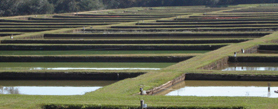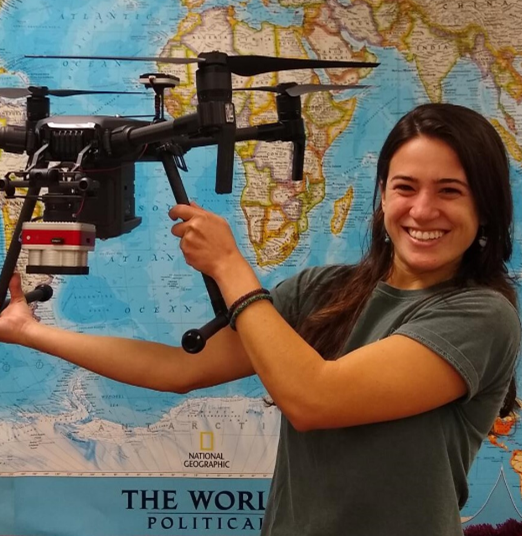potential projects
REU students will receive hands-on scientific training from one of several Auburn faculty mentors, who are experts in many subdisciplines of warm-water aquatic ecology. Moreover, the students will have opportunities to conduct their research in diverse ecosystems located throughout Alabama. Students will be encouraged to develop an independent research project with their mentor following acceptance into the program. Examples of potential REU projects can be found below.
|
This project will employ geospatial technologies, such as satellite remote sensing, unoccupied aerial systems (UASs or drones), and geographic information systems (GIS) to monitor and predict the distribution and abundance of algae and cyanobacteria in freshwater systems. The REU student will participate in both field and lab activities: collecting aerial imagery and in situ water samples in the field, measuring phytoplankton abundance using pigment extractions and cell counts in the wet lab, and processing and analyzing drone and satellite imagery using GIS in the computer lab.
Contaminant remediation from aquatic environments. Mentor: Dr. Dengjun "Kevin" Wang Polluted aquatic environments pose a great threat to the wildlife and human health. Mass production and widespread use of per- and polyfluoroalkyl substances (PFAS, also known as forever chemicals) are polluting our already fragile aquatic environments. This project will seek a treatment train technique that integrates physical sorption and chemical degradation to remove PFAS contaminants from water. Student will apply field sampling techniques to collect water samples, which will then be transferred to the lab for PFAS analysis. A series of separation techniques will be used to enrich PFAS for subsequent sorption and chemical degradation. The student will have the opportunity to use many analytical instrumentations for material characterization and chemical analyses.
Phenotypic plasticity in invasive jellyfish.
While some marine taxa face population declines due to increased sea surface temperatures, others are thriving almost to the point of being invasive. Our lab aims to investigate the molecular basis of the success of the jellyfish Cassiopea spp. globally. One way to approach this is to measure the extent of phenotypic plasticity in Cassiopea spp. from different populations to test if their invasiveness is due to wide tolerance to a variety of environmental stressors. The REU student will measure phenotypic plasticity in fitness traits such as growth and reproduction in jellyfish poylps and ephyra, the early life - history stages. We will collect adults and poylps from different sites with varying environmental histories in the Florida Keys. The REU student will then culture adult and early-stage jellyfish, develop skills in experimental design, and analysis in R. In addition to measuring phenotypic traits under different conditions, we are also interested in examining changes in gene expression and methylation in animals from these different sites. Findings from this study will be the baseline for further experiments developing Cassiopea jellyfish as a model to study phenotypic plasticity in the face of global change.
Assessment of undergraduate research experiences.
The Ballen lab is a research group in the Department of Biological Sciences at Auburn University. We conduct discipline‐based education research (DBER) on biology education and STEM equity through investigations of the causes and consequences of gaps in science literacy. Our interests in this field are broad, and one possible avenue for research is to study outcomes among students engaging in research during their undergraduate education. Studies on measurable outcomes of research experiences for undergraduates are often limited by small sample sizes. This project will harness a sizable database of students who engaged in research internships and reveal the effects of these experiences on measures obtained through a novel survey instrument (e.g., graduate school attendance, career plans, thinking like a scientist).
Teasing apart the factors related to taste and odor
compounds in drinking water and aquaculture reservoirs.
Taste and odor compounds, such as geosmin and MIB,
negatively affect drinking water and aquaculture-raised fish by
causing muddy flavors and odors. Despite significant
research dedicated to removing these compounds from water,
relatively little research has examined the abiotic (e.g.,
climate) and biotic (e.g., food-web interactions) factors
responsible for taste-and-odor episodes. The REU student
will work Alan and his graduate students to design and conduct
complex lab- and field-based experiments that help explain the
complicated interactions driving off-flavor production in
diverse aquatic systems.
Factors affecting bee nest use.
Honey bee nests are essential for colony function - it's where brood is reared, food is stored, and forage sites advertised. Nests of the honey bee are multi-purpose, a single cell can be used for pollen storage, nectar storage, brood rearing, or left empty. This project will look at how nest use changes over time, and how different parts of the nest are preferentially used for some nest contents over others. For this part of the project, students will learn skills in image analysis, using the python programming language. Prior expertise in coding is helpful, though not required. This investigation also involves field work - we will be inspecting colonies, and taking high-resolution photographs of their nests, including experiments with observation hives (colonies held between two panes of glass).
Molecular ecology of imperiled freshwater mollusks.
River impoundments and pollution have caused population fragmentation and decline of many freshwater mussel and snail species in North America. However, a lack of past research hinders conservation efforts. Genetic data, in particular, are needed to understand how remaining populations are connected, to examine genetic consequences of species decline, and to evaluate taxonomy. The REU student will use genomic techniques to examine how genetic diversity of mollusks varies across riverine landscapes, focusing on species of conservation concern. Potential study species include both mussels and snails, potentially the Alabama Pearlmussel or Black Mudalia snail. The student will have the opportunity to participate in fieldwork, and they will be trained in genomic data generation and analysis.
Applied reproductive biology and early life development of catfish for genetic cryobanking
Aquatic biodiversity is declining in the southeastern United States as more species are becoming extinct at an alarming rate. This will only increase as we see the results of global climate change taking effect in our rivers, lakes, and oceans. While little can be done to bring back an extinct species, we must work on securing the fate of imperiled species. To achieve this goal, interventional actions must be taken to create a collection of genetic information available as a safeguard; “buying us the time” necessary to improve aquatic habitats. This can be accomplished through gene banking using cryopreservation and artificial spawning techniques. Throughout the 10 weeks, the REU student will optimize cryo banking techniques (with cells frozen at -196C) and refrigerated storage of gametes. The student will then fertilize eggs from channel catfish females with these stored cells and track embryonic survival, hatch success, larval morphology, and deformities from offspring created with both fresh and cryopreserved spermatozoa. Skills learned: Florescent microscopy, flow cytometry, gamete cryopreservation, assisted reproductive techniques and technologies, and computer assisted gamete analysis
Examination of the factors associated with cyanobacterial toxin production.
There is still great debate in the harmful algal bloom community surrounding the conditions that lead to production of cyanobacterial toxins. Recent lab and field studies have started to point to cell-stress as a leading factor. This project will use a combination of field sampling and laboratory experiments to examine how nutrient limitation influences toxin production in cyanobacteria. The selected REU student will learn field sampling techniques along with analytical chemical analyses common in the fields of limnology, aquatic ecology, and water quality science.
Evaluating the responses of coastal marine fishes to fluctuations in temperature and salinity
Research in the Bernal Lab deals with understanding how marine fishes will respond to human-induced changes using a combination of phenotypic and genomic measurements. The REU student will conduct laboratory experiments testing how pinfishes (Lagodon rhomboides) from different populations of the Gulf of Mexico respond to increased CO2 and temperature. Experiments include understanding the effects of both stressors individually, evaluating the response to both stressors, and/or keeping one stressor constant while another one is variable. The student will be responsible for collecting phenotypic variables (oxygen consumption, size, weight) and behavioral observations, as well as tissues for future genomic analysis (livers and brains). This is a great opportunity to develop skills in fish husbandry and statistical analyses, while gaining valuable insight in experimental design with live animals. Findings form this study will be allow us to better-understand how marine organisms respond and acclimate to the impending effects of global change.
Turtles on the move
Movement through the environment is a process central to population ecology as it structures populations, impacts gene flow, and causes variation in reproductive success and survival. The aim of this project is to measure individual movements of the inimitable pond slider turtle (Trachemys scripta) and associate migratory behaviors to characteristics of the organisms as well as the habitats they are moving between. To accomplish this, the student will conduct intensive live-trapping in order to implement a capture-mark-recapture program alongside measurement of environmental variables. Students will be mentored in fieldwork, turtle biology, evolutionary ecology, and quantitative skills using the R statistical program. |



